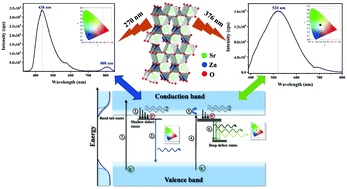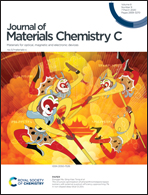Excitation energy dependent switchable emission in SrZnO2 nanophosphors: XAS and luminescence studies†
Abstract
SrZnO2 nanophosphors synthesized using a combustion technique with monoethanolamine fuel exhibited unprecedented wavelength selective luminescence in the blue and white region. The presence of lattice defects in rod shaped nanophosphors was established using X-ray absorption spectroscopy (XAS), thermoluminescence (TL) and photoluminescence (PL). X-ray absorption near edge structure at the Zn and Sr K-edges revealed a mismatch in experimental and theoretically simulated absorption edges, which was ascribed to the effect of lattice defects present in the system. Extended X-ray absorption fine structure analysis showed the squeezing of Zn coordination polyhedra and lengthening of Sr coordination polyhedra, thereby causing disorder in the structure resulting in the tailing of band edges. The consequences of these effects were observed in energy dependent luminescence corresponding to the above and below band gap photo-excitation. This trend in PL was explained with a schematic band model depicting transitions involving shallow and deep trapping states leading to dual emission in the visible region. Such energy dependent emission proposes SrZnO2 as a potential candidate for solid state lighting and white light emitting devices.



 Please wait while we load your content...
Please wait while we load your content...